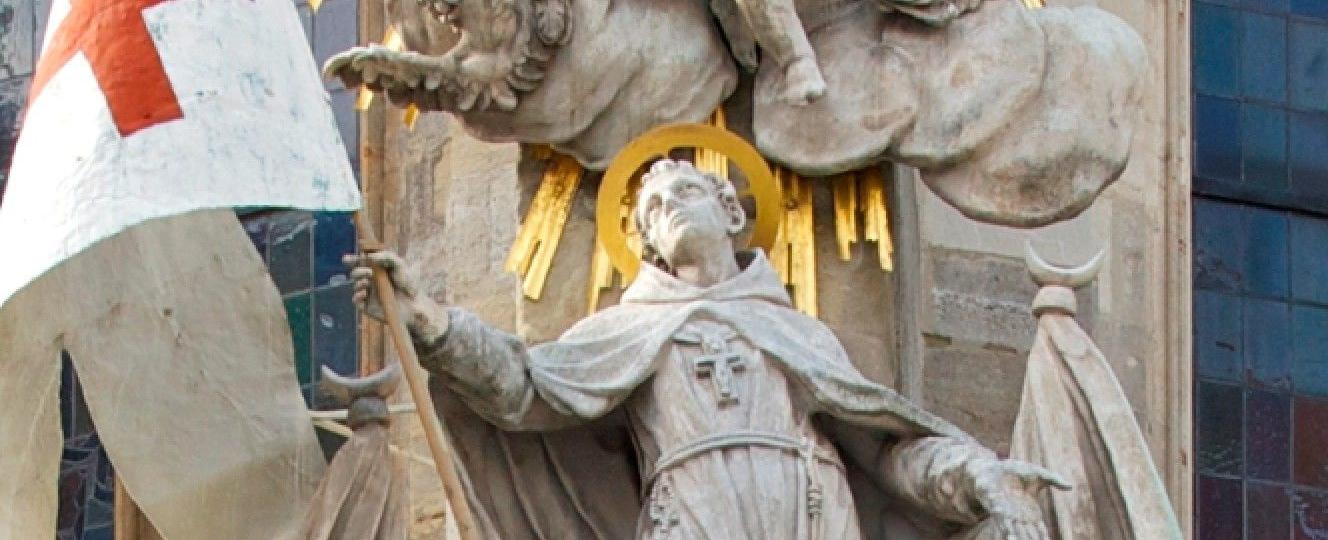St. John Capistran: Apostle of Europe

St. John Capistran (John of Capistrano, (1386–1456,) is a good example of what a strong faith, active involvement in society’s most pressing problems, and skilled communication can achieve. The memory of this Franciscan friar, canonized in 1690, recognized as “Apostle of Europe” (1956) and patron of military chaplains (1984), is celebrated every year on October 23. Yet, some aspects of his multifaceted activity appear less attractive, if not controversial nowadays.
Joining the Franciscan Order
A jurist with an excellent university education in civil and canon law, John joined the Franciscan Order just before he turned 30, late—by the standards of his time—renouncing his promising career as a judge in the city of Perugia (Italy), as also to the prospect of starting a family.

The town of Capestrano, Abruzzo, John's birthplace, is dominated by its castle.
Converting secularized society
In a few years he became one of the most renowned itinerant preachers of the time, working alongside St. Bernardine of Siena in preaching campaigns reaching more and more cities of Italy. Together, they succeeded in what a contemporary humanist described as the “real miracle” of converting the increasingly secularized Renaissance society of their time. Their contemporaries found their words convincing and appealing, and their preaching had numerous positive effects on contemporary society, divided by factionalism and internecine wars.
Reforming the Order
As the most preeminent jurist among the Observant Franciscans, John became immediately involved in the attempts to reform the Order, committing himself to writing new regulations and assuming leading institutional roles within the Order, including the Franciscan Third Order religious women, whose institutional foundations he laid. He became a direct collaborator of the Popes already under Martin V and Eugene IV, taking on the role of itinerant inquisitor, a task he carried out in close connection with his preaching, particularly against Franciscan dissidents, but later also against other heretics and infidels who did not recognize the superiority of the Pope, such as the Hussites of Bohemia, or even Jews and anti-unionist Orthodox.
Writing to important figures of the time
John was a very prolific writer, with an impressive literary output, including treatises, sermons, and a vast correspondence, that included letters to important figures of the time, such as Popes and cardinals, the emperor, kings, and dukes. A man of strong opinions, sometime overzealous, John was also a fierce polemicist, not only against dissidents against the Papal authority (the nature of which at the time was a debated issue), but also against certain humanists, who did not spare him their criticism.
Implanting reformed Franciscans in Europe
Had he ended his earthly life in 1451, John would have come down in history as an undoubtedly important figure in Christianity, but he certainly would not have been canonized as a saint. From that year on, his life took on a heroic turn in the eyes of his contemporaries. A “grand tour” of Central Europe led him through what is now Austria, southern Germany, Slovakia, Hungary, Romania, Serbia, and Croatia, where he died, on October 23, 1456. During those years he succeeded in replicating the successes achieved by Observant preaching in Italy, but also in implanting reformed Franciscans permanently (why his cult is particularly alive in Central Europe).

This painting by a local artist about 1470 shows John preaching in Bamberg, Germany, on a mission tour in 1452. A woman in the foreground is throwing her elaborate headgear into a “bonfire of the vanities” in response to his preaching.
Defending Belgrade
While revered by many as a living saint in the last years of life, he acquired even more lasting fame by his role in the defense of Belgrade in the face of an Ottoman army led by the Sultan himself, in June 1456, an achievement considered by many a miracle and a manifestation of God himself in human history (an imprint left by his “finger,” as a biographer later wrote). It seemed incredible to contemporaries that the unstoppable power of the Turks, who three years earlier had conquered Constantinople and were marching into the heart of Central Europe, could be stopped by an army not even half as large in numbers. Yet it happened, and when he received the new, Pope Callistus III decreed that it should become a feast day (it was August 6, which became the Feast of the Transfiguration). How this victory was even possible continues to be debated among historians to this day. While some objective arguments are indisputable (as the shrewd defense organized by the brilliant military strategist John Hunyadi or the plague that was ravaging the Ottoman camp), the role of John Capistran remains unquestionable.

This image of John depicted as a “soldier saint” can be found at Mission San Juan Capistrano in California.
Instilling courage among Belgrade’s defenders
John was not a warrior, he never wore armor (as some later representations portray him), nor touched a sword. Facing the Turks, in Belgrade, he held a staff surmounted by the Franciscan Tau, encouraging the defenders of the citadel to resist through his speech and gestures. He was a model and an inspirer. Many of the defenders of Belgrade were volunteers gathered through his preaching and were particularly attached to him personally and to the crusading spirit he was able to instill in them. He was confident in victory and his confidence was contagious for the other defenders, instilling in them the courage to hold out, even in the most difficult moments.
Inspiring defense of common ideals
The more skeptical might limit his role to the category of psychological factors. Even so, that also remains essential. For some 70 years the Ottoman advance was halted as a result, and John, by choosing to be buried in the nearby convent of Ilok, continued through his incipient cult to foster resistance in the inhabitants of the region. Warrior saints may not be very attractive in our days, but John’s life is still an inspiration for those who defend common ideals, such as freedom or their country.
-----
The header image is from a heroic statue of John outside St. Stephen’s Cathedral in Vienna.
Iulian M Damian
Senior lecturer and Assistant Professor, Babe?-Bolyai University, Romania
Dr. Iulian M. Damian, a native of Romania, is senior lecturer and assistant professor in the Classics Department, Faculty of Letters, at Babe?-Bolyai University in Cluj-Napoca, Romania. He teaches classical Latin at all levels, medieval and Renaissance Latin literature, as well as ancient and medieval history. He earned a PhD in history in 2008 at the Babe?-Bolyai University with a thesis on John of Capistrano and the Later Crusade. Dr. Damian is a Fulbright Visiting Scholar at the Franciscan Institute at St. Bonaventure University (Fall 2022).

